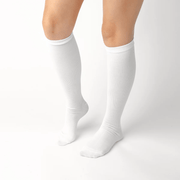Compression socks have become a popular tool among athletes and fitness enthusiasts for managing and preventing shin splints—medial tibial stress syndrome that causes pain along the shin bone. Characterized by inflammation of the muscles and tissues around the tibia, shin splints often result from strenuous activity, improper footwear, or sudden increases in training intensity. Incorporating compression socks or calf compression sleeves into your routine can help alleviate symptoms, promote blood circulation, and reduce the risk of further injury.
How Compression Socks Help Shin Splints
Compression socks work by applying gentle pressure to the lower legs, enhancing blood flow and reducing lactic acid buildup in the calf muscles [1]. Improved circulation delivers oxygen and nutrients more efficiently, which helps the body heal naturally and reduces inflammation. By stabilizing muscles and providing extra support around the shin bone, compression socks help minimize microtrauma during physical activity.
Many athletes experience shin splints when their workout routine lacks proper progression or adequate recovery. Wearing compression socks during and after exercise can shorten the recovery process by promoting faster removal of metabolic waste. Compression levels range from mild (15–20 mmHg) to firm (20–30 mmHg), and choosing the best compression socks for your needs depends on the severity of your symptoms and any existing health conditions.
Practical Tips for Using Compression Socks
-
Fit Correctly: Trouble finding the right size is common. Visit a medical supply store or specialty running shop for professional fitting, ensuring the socks or sleeves provide uniform pressure without cutting off circulation.
-
Use During Activity: Wear compression socks when running, cross-training, or engaging in any high-impact exercise. By supporting the lower legs, compression socks help prevent shin splints and reduce calf muscle fatigue.
-
Combine with Prevention Tips: In addition to compression therapy, incorporate a balanced diet, frequent breaks during training, and proper arch support. Rotate between ice application (cold therapy) and gentle stretching to further reduce inflammation.
-
Gradual Introduction: For severe cases, start with shorter durations—wear compression sleeves for 1–2 hours—and gradually increase to all-day use as symptoms improve. This approach helps avoid excessive pressure that could lead to discomfort or skin irritation.
Complementary Treatment Options
While compression socks can alleviate pain and promote faster recovery, they should be part of a broader treatment plan. Applying ice to the affected area for 10–15 minutes post-exercise helps reduce swelling. Regular strength training focusing on calf and foot muscles builds resilience against future injuries. If shin splint pain persists, consult a healthcare provider about orthotics or physical therapy.
Conclusion
Shin splints are a common injury among athletes, but compression socks for shin splints offer a simple, research-backed method to manage and prevent symptoms. By improving blood circulation, reducing inflammation, and providing extra support, compression socks can be a valuable component in any athlete’s prevention and recovery toolkit.
References
[1] Journal of Sports Medicine, “Effects of Graduated Compression on Muscle Recovery,” 2020.
 Active Compression
Active Compression
 Plain Compression Socks
Plain Compression Socks

